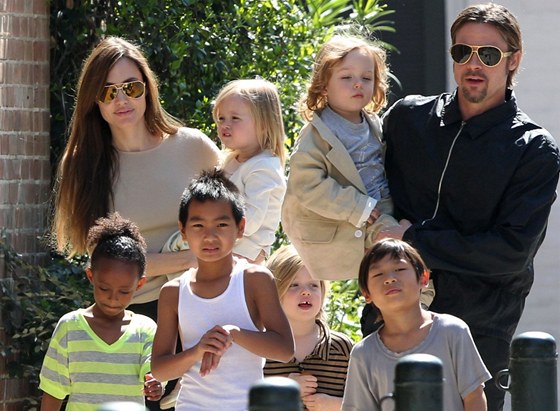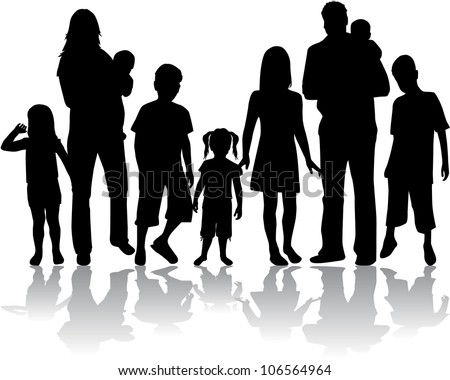Perspectives in Favour of Adoption
Adoption is the process a couple or individual takes in order to legally transfer permanent responsibility and parental rights from the child’s biological parents to the adopting parents. [1] The rise in population along with number of children without a home make the need for adoption a prevalent one in today's society. There are many reasons why an individual or couple may find adoption beneficial for themselves along with the child. After all, children worldwide are the future.

Infertility
Infertility is one of the most common reasons why couples decide to adopt a child to expand their family. [2] Infertile women are those who are unable to conceive a child due to their biological clock or a health condition. According to 2008 world population statistics and estimates taken from infertility clinics, 72.4 million women, 9% of women, were infertile. [3] Since then, those numbers have gone up, and by 2012 the infertility rate rose to between 11.5% to 15.7%. [4] Infertility in men are typically due to health conditions which affect either their sperm production or sperm transportation. Two-thirds of men who are infertile are said to have problems producing sperm in their testes. [5] These couples are usually advised on other options in which to expand their families and typically lean towards adoption.

Biological Clock
Couples with female partners between the age of 35 – 44 years, who do not have many children (0 or 1), have a considerably higher probability of undergoing current infertility in comparison to females between the ages of 18 – 34 years old. [4]

Same Sex Couples
As society has developed over time, there has been a growing liberal perspective and acceptance in regards to the LGBTQ+ community. This can be seen through public figures such as Ellen DeGeneres and Neil Patrick Harris. It is an unfortunate fact that these couples currently cannot reproduce on their own due to biological reasons and have to therefore look to other resources to aid them in continuing their legacy. Although there are artificial inseminations and surrogacy methods available, many same sex couples turn to adoption to add children into their families. [6] Roughly 21.2% of same-sex families in the United States adopt children with no biological connection to themselves. [7]

Struggles of Same Sex Couples
Unfortunately, some same-sex couples still undergo legal issues in terms of the adoption process. There is still a barrier between the legitimacy of homosexual parents in comparison to heterosexual parents in regards to the child’s physical and mental health development, along with the misconception that the child will not be able to develop an appropriate gender and sexuality identity. Currently, there are only certain countries which allow same sex couples to adopt. These include: Canada, the United Kingdom, Netherlands, Sweden, Spain and certain parts of the United States. [8]
Environmental Reasons
Many individuals believe there is currently a population control issue at hand. Due to this, some couples turn to adoption rather than having their own child in order to avoid adding to the world’s carbon footprint [9] Population control has been a major issue in many developing countries such as China, India and Africa. [10] [11] [12] Many individuals believe we need to work towards population control and look to adoption as one of these methods in which to serve society through.
Kinship Care
Helping Friend
In some situations, a couple may want to aid a friend who cannot handle the responsibility of raising a child. In this instance, couples adopt the child in order to give him or her the best life possible. Similarly, a friend may be given twins and not be able to raise both infants simultaneously. A couple may then come in and adopt one of the two twins in order to make the biological parents’ lives more manageable. [6]

Orphaned Child
Adoption within friend circles is also a prevalent occurrence when a child’s biological parents may no longer be able to care for them due to mortality, prison or addiction. [13] In these situations, family members or close friends may be asked to step in and adopt the child. Family, in general, is always contacted at first in these circumstances. [9]
Foster Children
Families who foster children, along with individuals who volunteer at orphanages, typically end up establishing strong bonds with the children, which can result in the desire to adopt them once their time in foster care runs out. [14] Foster parents often get into a routine of having the child around for many years. Once the child becomes available for adoption, the foster parents inherently wish to maintain the connection in most cases and make them permanent members of their families. Maintaining this connection and familiarity is extremely beneficial for the child as he or she is already comfortable and does not need to be put into another unfamiliar environment again. [9]
Step Parents
With the prevalence of divorce in today’s society, it is not uncommon for individuals who remarry to have children from their first marriage. When remarrying, a stepparent may wish to adopt his or her significant other’s children in order to share the custody and responsibility. Through this, the stepparent gains full parental rights from the biological parents no longer in the marriage. [15]
Philanthropy
There are many children around the world, both domestically and internationally, who are in need of a loving home. There are an estimated 140 million children worldwide who are currently orphans. [16] Many individuals see adoption as a noble cause in order to help decrease the number of orphans worldwide. This occurrence has been drastically glamorized by the media through the adoption mannerism of many celebrities, such as Angelina Jolie and Brad Pitt. [10] These celebrates adopt children from around the world and give them a better life. This is seen as charity work to some, as this is giving back to the society. Many celebrates along with ordinary citizens tend to adopt children for these reasons as it not only helps society but it also helps a child in need.

Gender of the Child
The modern image of a healthy family is typically a husband, wife and two kids, who are usually imagined to be a boy and a girl. [10] However, as we can see in our day to day lives, this is not always the case because the sex of the children cannot be manipulated with proven safe health care methods. A family may have children of the same gender and wish to look towards adoption as another alternative way of welcoming a child from a specific gender into their family. [6]

Health
Pregnancy Complications
It may not be as simple as just wanting to have a child from a specific gender as mentioned above. Often times, couples may not be able to have another child due to health complications such as cardiovascular disease, epilepsy or multiple caesarean births, which makes getting pregnant a hazardous health risk for the mother and infant. This is called secondary infertility and occurs when the couple has previously had successful pregnancies and now find themselves unable to conceive again. [9] Due to this, adoption has become a key way of expanding the modern family. Especially in cultures outside North America, where it is typical to have rather large families. [17]

Genetic Disorders and Diseases
Couples who encounter genetic disorders, such as Thalassemia or other high-risk genetic problems, may wish to adopt a child in order to avoid passing down these undesirable traits to their children. [10] This enables the couple to experience the fulfillment of having a family, while avoiding the anxiety of hypothetically burdening the child with the potential disorder or disease [13]
Avoiding Labour
Labour is a long and painful experience which many women are scared of. There are many complications with labour such as fetal distress, breech position, placenta previa and more, which make the idea of labour rather frightening. [18] Roughly 830 woman die a day due to preventable causes related to pregnancy and childbirth, most of which occur in developing countries. [19] In light of this, and the desire to maintain their figure after child birth, some women lean towards adoption rather than childbirth. [10]
Single
Statistically in the United States 40% to 50% of marriages end in divorce. [20] Along with this factor, marriages have decreased from 7.9 per every 1000 people in 2008 to 6.9 per every 1000 people by 2015. [21] Due to these figures, more and more individuals who claim to be “chronically single” and “don’t believe in love” are straying away from marriage but still wish to create a family and fulfill that aspect of their lives. Due to this longing, many individuals look towards adoption in order to expand their family.
Along with this longing to expand an individual’s family in today’s fast paced society, individuals also often run into emotional voids. Therefore, they look to fill these voids through strong connections which can be found through adopting a child. [10] As a single individual, one may also want to experience the joys of parenthood without the attachment of a partner. An example of this is Miss Universe and film actress Sushmita Sen, a single mother who adopted a young girl and described the situation simply as “this little girl needed a mom and I needed a child”. [6] This is not limited to only celebrities, as many ordinary citizens do this in order to experience this aspect of life.

Love for children
Some couples or individuals naturally have a paternal instinct and want to help children have a better life, whether it is their own biological children or adopted. Couples have shown love to children so much that they lean towards adopting more children regardless of if they have, or are able to have, their own children. [6] These couples wish to help the children have a better life because the children typically come from rough backgrounds involving abusive or unfit parents. Due to this background, the children can develop angry, fearful or bleak perspectives on life without the guidance of a nurturing support system. [14] Through adopting these children, families are able to provide the much needed support and love deserved and required for the child to move forward in life.
Adopting an Older Child
The concept of being responsible for an infant may not be as appealing to some couples. However, with adoption, couples have the option to adopt older children and avoid all the concerned regarding the first few years of parenting. This way, the couple can skip the physical and mental stress of baby proofing their house but still be able to prove a better life for a child. [6] Although adopting an older child may be troublesome due to adolescent rebellion, some parents find it easier to connect on a personal level with a child who is older and who can understand the concept of being adopted as a blessing rather than a right. Adopting an older child also gives the parents more independence to continue their daily routine knowing the child can also take care of small tasks by themselves, unlike an infant.

References
- ↑ FAQ. (n.d.). Retrieved November 9, 2015, from https://www.adoption.on.ca/what-is-adoption
- ↑ "10 Reasons Why People Adopt." RainbowKids.com. Accessed April 11, 2017. http://www.rainbowkids.com/adoption-stories/10-reasons-why-people-adopt-1607
- ↑ Boivin, J., L. Bunting, J. A. Collins, and K. G. Nygren. "International estimates of infertility prevalence and treatment-seeking: potential need and demand for infertility medical care." Human reproduction (Oxford, England). June 2007. Accessed April 11, 2017. https://www.ncbi.nlm.nih.gov/pubmed/17376819.
- ↑ 4.0 4.1 Bushnik, Tracey, Jocelynn L. Cook, A. Albert Yuzpe, Suzanne Tough, and John Collins. "Estimating the prevalence of infertility in Canada." Human Reproduction (Oxford, England). March 2012. Accessed April 11, 2017. https://www.ncbi.nlm.nih.gov/pmc/articles/PMC3279129/.
- ↑ "Infertility in men." University of Maryland Medical Center. Accessed April 11, 2017. http://www.umm.edu/health/medical/reports/articles/infertility-in-men.
- ↑ 6.0 6.1 6.2 6.3 6.4 6.5 "Top 10 Reasons to Adopt a Kid." List Dose. September 12, 2014. Accessed April 11, 2017. http://listdose.co/top-10-reasons-to-adopt-a-kid/. Cite error: Invalid
<ref>tag; name "two" defined multiple times with different content - ↑ Adoptions, Lifelong. "Lgbt adoption." LifeLong Adoptions. Accessed April 11, 2017. https://www.lifelongadoptions.com/lgbt-adoption/lgbt-adoption-statistics.
- ↑ Farr, R. H., Farr, R. H., Forssell, S. L., & Patterson, C. J. (07/16/2010). Applied developmental science: Parenting and child development in adoptive families: Does parental sexual orientation matter? Lawrence Erlbaum Associates Inc. doi:10.1080/10888691.2010.500958
- ↑ 9.0 9.1 9.2 9.3 Kostelyk, Sharla. "Common Reasons People Adopt." Adoption Magazine. September 10, 2015. Accessed April 11, 2017. http://www.theadoptionmagazine.com/common-reasons-people-adopt/.
- ↑ 10.0 10.1 10.2 10.3 10.4 10.5 "Top 10 Reasons to Adopt a Kid." List Dose. September 12, 2014. Accessed April 11, 2017. http://listdose.co/top-10-reasons-to-adopt-a-kid/. Cite error: Invalid
<ref>tag; name "top" defined multiple times with different content - ↑ "Topic Area: Population Control." Topic Area: Population Control. Accessed April 11, 2017. http://personal.colby.edu/personal/t/thtieten/Famplan.htm.
- ↑ Huang, R. "Population control and community economic development in southern Jiangsu." Chinese journal of population science. Accessed April 11, 2017. https://www.ncbi.nlm.nih.gov/pubmed/12319014.
- ↑ 13.0 13.1 "10 Reasons Why People Adopt." RainbowKids.com. Accessed April 11, 2017. http://www.rainbowkids.com/adoption-stories/10-reasons-why-people-adopt-1607.
- ↑ 14.0 14.1 "Reasons To Adopt A Child." Adoption Network. Accessed April 11, 2017. https://adoptionnetwork.com/reasons-to-adopt-a-child.
- ↑ "Stepparent Adoption FAQ's." Findlaw. Accessed April 11, 2017. http://family.findlaw.com/adoption/stepparent-adoption-faq-s.html.
- ↑ "Worldwide Children's Statistics." SOSUS. Accessed April 11, 2017. http://www.sos-usa.org/our-impact/childrens-statistics.
- ↑ "Why Do the Poor Have Large Families?" Compassion Australia. Accessed April 11, 2017. https://www.compassion.com.au/blog/why-do-the-poor-have-large-families.
- ↑ Admin-mdp. "Delivery Room Drama." Fit Pregnancy and Baby. April 03, 2017. Accessed April 11, 2017. https://www.fitpregnancy.com/pregnancy/labor-delivery/delivery-room-drama.
- ↑ "Maternal mortality." World Health Organization. Accessed April 11, 2017. http://www.who.int/mediacentre/factsheets/fs348/en/.
- ↑ Pardon Our Interruption. Accessed April 11, 2017. http://www.apa.org/topics/divorce/.
- ↑ Collins, Lois M. "U.S. marriage rate hits new low and may continue to decline." DeseretNews.com. May 20, 2015. Accessed April 11, 2017. http://www.deseretnews.com/article/865629093/US-marriage-rate-hits-new-low-and-may-continue-to-decline.html.